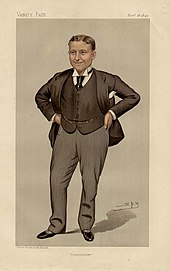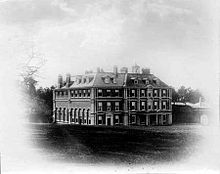| The Right HonourableThe Viscount BurnhamGCMG CH TD JP DL | |
|---|---|
 | |
| Member of the House of Lords | |
| Lord Temporal | |
| In office 9 January 1916 – 20 July 1933 | |
| Preceded by | The 1st Baron Burnham |
| Succeeded by | The 3rd Baron Burnham |
| Personal details | |
| Born | Harry Lawson Webster Levy (1862-12-18)18 December 1862 St Pancras, London, England |
| Died | 20 June 1933(1933-06-20) (aged 70) |
| Resting place | Beaconsfield, Buckinghamshire, England |
| Political party | Liberal Party Liberal Unionist Party Conservative Party |
| Spouse |
Olive de Bathe (m. 1884) |
| Children | 1 |
| Parents |
|
| Education | Eton College |
| Alma mater | Balliol College, Oxford |
| Occupation | Newspaper owner |
Harry Lawson Webster Levy-Lawson, 1st Viscount Burnham, GCMG, CH, TD, JP, DL (18 December 1862 – 20 July 1933), was a British newspaper proprietor. He was originally a Liberal politician before joining the Liberal Unionist Party in the late 1890s. He sat in the House of Commons 1885–1892, 1893–1895, 1905–1906 and 1910–1916 until he inherited the Burnham barony on the death of his father.
Biography
Levy-Lawson was born in St Pancras, London, in 1862, the son of Edward Levy (who was created Baron Burnham in 1903) and his wife Harriette Georgiana Webster. The family name was legally changed from Levy to Levy-Lawson on 11 December 1875.
He was educated at Cheam School, Headley, Berkshire, Eton and Balliol College, Oxford. He became a lieutenant in the Royal Buckinghamshire Yeomanry, treasurer of the Free Land League, vice president of the Municipal Reform League, and a member of the executive committee of Municipal Federation League. In 1891, he was admitted to the Inner Temple, entitling him to practise as a barrister.

Levy-Lawson was elected Member of Parliament (MP) for St Pancras West in the 1885 general election at the age of 23, but lost the seat in the 1892 general election. He was also a member of the London County Council from 1889 to 1892, for St Pancras West.
He was returned to the Commons as MP for Cirencester at a by-election in 1893 and held the seat until his defeat at the 1895 general election. In 1905 he was elected at a by-election as MP for Mile End and lost the seat in 1906, regaining it in January 1910. In the interim he was Mayor of Stepney between 1907 and 1909. In 1911, he was appointed a deputy lieutenant of Buckinghamshire.
Levy-Lawson was appointed a captain in the Royal Buckinghamshire Yeomanry on 1 May 1887, and later gained the honorary rank of major. He was promoted to lieutenant-colonel and appointed in command of the regiment on 18 October 1902.
He saw active service in the First World War, where he was mentioned in despatches. In 1916, on the death of his father, he succeeded to the titles of Baron Burnham and the baronetcy and took his seat in the House of Lords. He also succeeded his father in the management and ownership of The Daily Telegraph. He was decorated with the Territorial Decoration (TD) and became Honorary Colonel of the 99th (Bucks and Berks Yeomanry) Brigade, Royal Artillery. He was invested as a Member of the Order of the Companions of Honour (CH) in 1917.
He was the first chairman of the Burnham Committees on teachers' pay, which were named after him.
Family, interests and Hall Barn

Levy-Lawson was created Viscount Burnham, of Hall Barn, in the County of Buckingham, on 16 May 1919. He married Olive de Bathe, daughter of Sir Henry de Bathe, 4th Baronet, and Charlotte Clare, on 2 January 1884 at St. Margaret's Church, Westminster. They had one daughter, Dorothy Olive Lawson (1885–1937), who married Major John Spencer Coke (son of Thomas Coke, 2nd Earl of Leicester) and with whom she had three children: Gerald, Celia and Rosemary Coke – the latter later Baroness Hamilton of Dalzell.
His father, who was "one of the Prince of Wales' set", had purchased the 4,000-acre Hall Barn estate in 1880. Viscount Burnham and his father hosted King Edward VII and his son, King George V, and his son King Edward VIII on many occasions from the early 1900s to the 1930s. On 19 December 1924, for example, Burnham hosted a dinner party for King George V with Rudyard Kipling, Harry's daughter, Dorothy Levy-Lawson, and her husband, Major Sir John Coke, amongst the guests.
Viscount Burnham was a JP for Buckinghamshire. He received a number of honorary doctorates from McGill University, Montreal, in 1920, Durham University in 1921, Athens University, Greece, in 1924, University of Western Australia, Perth, Australia, in 1925, Ghent University, Belgium, in 1927 and Cambridge University. He was invested as a Knight Grand Cross, GCMG, in 1927. In 1928 he sold The Daily Telegraph to Lord Camrose and Lord Kemsley of Allied Newspapers, with Camrose taking over as editor-in-chief.
He died aged 70 and was buried near his father on 24 July 1933 at Beaconsfield, Buckinghamshire. Burnham had no surviving male issue so the viscountcy became extinct: his younger brother, William Levy-Lawson (1864–1943), succeeded to the baronetcy and barony.
Arms
|
References
- Debretts Guide to the House of Commons 1886
- Craig, F. W. S. (1989) . British parliamentary election results 1885–1918 (2nd ed.). Chichester: Parliamentary Research Services. ISBN 0-900178-27-2.
- "No. 28504". The London Gazette. 16 June 1911. pp. 4514–4515.
- Hart′s Army list, 1902.
- "No. 27483". The London Gazette. 17 October 1902. p. 6570.
- "Records of the Salaries Branch and Burnham Committees". The National Archives. Retrieved 18 December 2021.
- Kidd, C. (1990). Debrett's Peerage and Baronetage 1990. Debrett's Peerage 1990. ISBN 9780333388471. Retrieved 3 August 2016.
Rosemary Olive (Baroness Hamilton of Dalzell), b 1910: m 1935, 3rd Baron Hamilton of Dalzell. Residence – Garden Cottage, Snowdenham House, Bramley, Guildford.— Celia Dorothy, b 1919: m 1942, Stamp Godfrey Brooksbank, Capt ...
- Kipling, R. (1990). The Letters of Rudyard Kipling: 1920-30. University of Iowa Press, 1990. p. 189. ISBN 9780877456575. Retrieved 22 July 2015.
...Lord Astor...Lord (Harry) Burnham, his brother and duplicate, his son-in-law (Sir John Spencer Coke)...I (Kipling) sat next to the King....
- Debrett's Peerage. 2019. p. 1908.
External links
- Hansard 1803–2005: contributions in Parliament by Harry Levy-Lawson
- Portraits of Harry Lawson Webster Lawson, 1st Viscount Burnham at the National Portrait Gallery, London

| Parliament of the United Kingdom | ||
|---|---|---|
| New constituency | Member of Parliament for St Pancras West 1885–1892 |
Succeeded byHarry Graham |
| Preceded byThomas Chester-Master | Member of Parliament for Cirencester 1893–1895 |
Succeeded byBenjamin Bathurst |
| Preceded bySpencer Charrington | Member of Parliament for Mile End 1905–1906 |
Succeeded byBertram Straus |
| Preceded byBertram Straus | Member of Parliament for Mile End Jan 1910 – 1916 |
Succeeded byWarwick Brookes |
| Peerage of the United Kingdom | ||
| New creation | Viscount Burnham 1919–1933 |
Extinct |
| Preceded byEdward Levy-Lawson | Baron Burnham 1916–1933 Member of the House of Lords (1916–1933) |
Succeeded byWilliam Levy-Lawson |
| Baronetage of the United Kingdom | ||
| Preceded byEdward Levy-Lawson | Baronet of Hall Barn 1916–1933 |
Succeeded byWilliam Levy-Lawson |
- 1862 births
- 1933 deaths
- Military personnel from the London Borough of Camden
- Burials in Buckinghamshire
- Liberal Party (UK) MPs for English constituencies
- People educated at Eton College
- Alumni of Balliol College, Oxford
- UK MPs 1885–1886
- UK MPs 1886–1892
- UK MPs 1892–1895
- UK MPs 1900–1906
- UK MPs 1910
- UK MPs 1910–1918
- UK MPs who inherited peerages
- Barons Burnham
- Viscounts Burnham
- People from St Pancras, London
- British Army personnel of World War I
- Deputy lieutenants of Buckinghamshire
- Members of the Inner Temple
- Members of London County Council
- Royal Buckinghamshire Yeomanry officers
- Mayors of places in Greater London
- Members of Stepney Metropolitan Borough Council
- Progressive Party (London) politicians
- Conservative Party (UK) MPs for English constituencies
- Liberal Unionist Party MPs for English constituencies
- Jewish British politicians
- Conservative Party (UK) hereditary peers
- Viscounts created by George V
- 19th-century British Army personnel
